Aviation against tanks (part of 4)
Despite the low efficiency of supersonic fighter-bombers in direct aviation support for ground units and actions against tanksUntil the early 70s, the Air Force leadership did not see the need for a low-speed armored attack aircraft. Work on the creation of such an aircraft began on the initiative of the command of the Ground Forces.
The Ministry of Aviation Industry of the USSR issued 1969 of the year in March for official design assignment for an attack aircraft. After that, for a long time it was not possible to agree on the characteristics of the machine. Air Force representatives wanted to get a plane with a high maximum speed, and the customer in the person of the Ground Forces wanted to have a machine that was highly vulnerable to anti-aircraft fire and could precisely “pick out” well-protected firing points and fight single tanks on the battlefield. It is clear that the designers could not meet such conflicting requirements, and they did not immediately come to a compromise. The competition was attended by the Sukhoi Design Bureau with the T-8 project (Su-25), the Ilyushin Design Bureau (Il-42), the Yakovlev Design Bureau (Yak-25ЛШ), and the Mikoyan OKB - MiG-21ЛШ. At the same time during the competition, it was decided to stop work on the IL-42 and Yak-25ЛШ.
The MiG-21LSH was created on the basis of the MiG-21 fighter, but as a result, there was little left of him in the new aircraft, the attack aircraft basically had to be re-designed. Initially, MiG designers planned to turn a simple and reliable MiG-21 fighter into a MiG-21Sh attack plane in the shortest possible way. It was supposed to get by with “little blood” - to install on the MiG-21 a new wing of increased area with additional weapon suspension points and a new aiming and navigation equipment. However, calculations and estimates have shown that it is unlikely that it will be possible to solve the problem in this way, with achievement of the required efficiency. It was decided to significantly upgrade the construction of the "twenty-first", to pay more attention to issues of survivability and weapons.
An attack aircraft was designed with a short, strongly sloping front fuselage, which gave a good overview. The layout of the aircraft has changed significantly; according to the MiG-21Sh project, the tailless model should have a low-lying, lively wing of a large area, side air intakes, a powerless, economical engine. Cab reservations provided protection against small-arms fire. weapons and splinters. The armament included a built-in 23-mm gun GSH-23, bombs and a NAR with a total weight of up to 3 t, at nine external points of suspension.
But before the construction of a flying prototype, it never came. By that time, the main modernization potential of the MiG-21 was exhausted and the creation of a new attack aircraft based on it was considered unpromising. In addition, the Design Bureau was overloaded with orders on fighter topics and could not allocate enough resources to quickly create a promising armored combat aircraft.
The OKB, under the leadership of P.O. Sukhoi, presented a completely new project T-8, which has been developed in a proactive manner for a year. Thanks to the use of the original layout and a number of new technical solutions, smaller than its competitors in size and weight, this project won the competition. After that, together with the customer, the parameters of the future attack aircraft were refined. Great difficulties arose in negotiating the maximum speed. The military agreed that in terms of detecting and hitting small ground targets, subsonic operating speed is optimal. But at the same time, arguing the need to break through the enemy’s front-line air defense, they wanted to have an attack aircraft with a maximum flight speed near the ground of at least 1200 km / h. At the same time, the developers indicated that the aircraft operating over the battlefield or up to 50 km behind the front line does not overcome the air defense zone, but resides in it. And in connection with this, it was proposed to limit the maximum speed at the ground to 850 km / h. As a result, the agreed maximum ground speed, recorded in the tactical and technical requirements, was 1000 km / h.
The first flight of the attack aircraft prototype took place on February 22 1975. After the first flight of the T-8-1, test pilot V.S. Ilyushin stated that the aircraft was very heavy in roll control. Another significant disadvantage of the T-8-1 was its low thrust-to-hand ratio. The transverse control problem was solved after the boosters were installed in the aileron control channel. And an acceptable thrust-to-weight ratio was obtained by adapting the unformatted version of the Р13F-300 turbojet engine with a maximum load of 4100 kgf. Engine modified for installation on attack aircraft known as P-95Sh. The design of the engine was enhanced compared with the prototype previously used on the MiG-21, Su-15 and Yak-28 fighters.
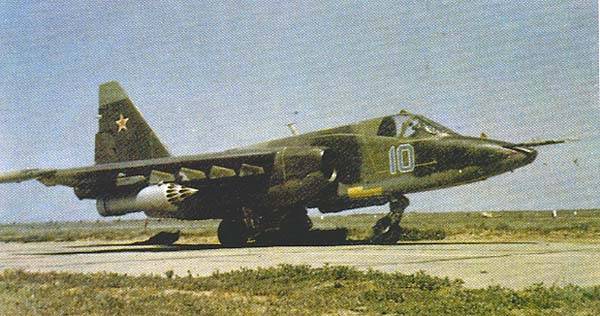
State assault trials began in June 1978. Before the state tests, the aiming-navigation complex of the aircraft underwent a significant modernization. On the T-8-10 instance, the equipment used on the Su-17MZ fighter-bomber was mounted, including the ASP-17БЦ-8 sight and the Klen-PS laser rangefinder. This made it possible to use the most advanced at the time guided aircraft weapons. The built-in artillery armament was represented by the GS-30-2 air gun with a rate of fire of up to 3000 rpm. Compared to the GSH-23, the weight of a second salvo increased more than 3 times.
In terms of anti-tank potential, only the Il-25Sh could compare with the Su-28 of the existing Soviet combat aircraft, but the attack aircraft, converted from a front bomber, did not carry such impressive protection and did not build them much. On eight Su-25 nodes, UB-32 units with 256 57-mm NAR C-5 or B-8 with 160 80-mm C-8 could be suspended. An attack aircraft could sow anti-tank bombs over a large area with the help of eight RBC-500 and RBC-250.
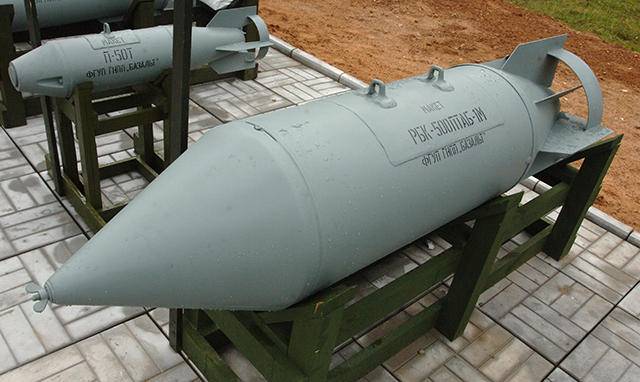
One-time bomb cassette RBK-500 mass 427 kg contains 268 combat elements PTAB-1М with armor penetration to 200 mm. This is more than enough to destroy tanks and armored vehicles on top. Improved RBC-500U PTAB mass 520 kg, has 352 cumulative elements.
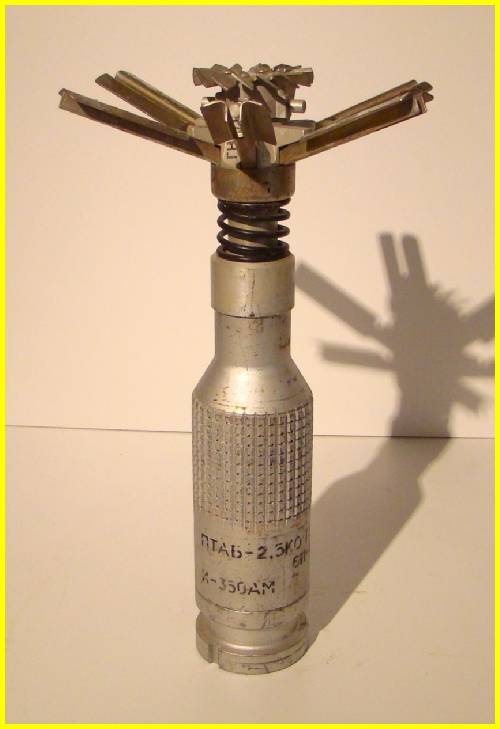
One-time bomb cassette RBK-250 PTAB-2,5М, weight 248 kg contains 42 PTAB-2,5М or PTAB-2,5KO. When two bomb cartridges are opened at a height of 180 m, anti-tank bombs are scattered over an area of 2 ha. PTAB-2,5M mass 2,8 kg was loaded with 450 g BB TG-50. When hit at an angle 30 °, the thickness of the pierced armor is 120 mm.
The arsenal of the Su-25 includes RBC-500 SPBE-D equipped with 15 self-targeting anti-tank combat elements with infrared guidance SPBE-D. For guidance used a separate command module.
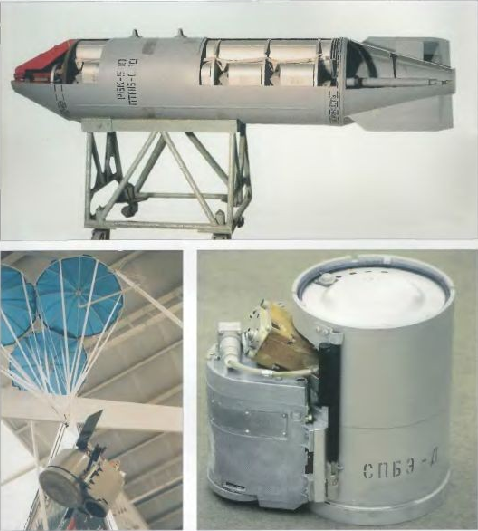
Each striking element weighing 14,9 kg is equipped with three small parachutes with a speed of descent 15-17 m / s. After the ejection of the striking elements, the IR coordinator is released with inclined rectangular wings, which provide rotation at a speed of 6-9 rpm. The coordinator scans with a viewing angle of 30 °. When a target is detected, the detonation point of the striking element is determined using an onboard computer.
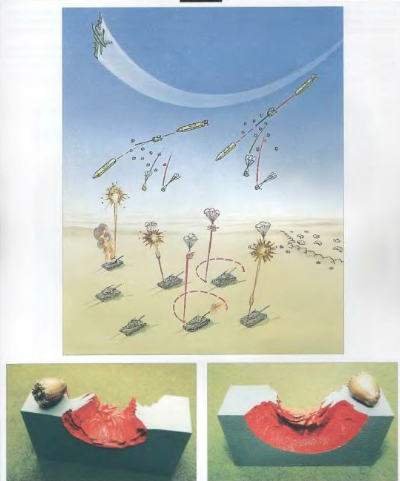
The target is hit with a copper impact core weighing 1 kg, accelerated to a speed of 2000 m / s. The thickness of the pierced armor at an angle of 30 ° to the normal is 70 mm. The bomb cassette equipped with self-targeting combat elements is used in the 400-5000 m altitude range at a carrier speed of 500-1900 km / h. Simultaneously, one RBC-500 SPBE-D can be hit up to 6 tanks.
In addition to one-time bomb cassettes, anti-tank ammunition on the Su-25 can be fitted out at KMGU (a universal container for small loads). In contrast to the RBC-120 and RBC-500, suspended containers with small submunitions are not discharged with the normal use of weapons, although in an emergency situation there is the possibility of forced dumping. Submunitions that do not have hanging ears are placed in a container in special blocks - BKF (container blocks for front aviation).

The container consists of a cylindrical body with rear stabilizers and contains 8 BKF with bombs or mines. KMGU electroautomatic equipment provides ammunition discharge in series at intervals: 0,05, 0,2, 1,0 and 1,5. The use of aircraft weapons from KMGU is carried out at a speed of 500-110 km / h, in the height range 30-1000 m. The mass of an empty container 170 kg, curb - 525 kg.
In the literature devoted to anti-aircraft aviation weapons, anti-tank mines are rarely mentioned. At the same time, the minefields, quickly placed on the battlefield, can be even more effective than the air strike inflicted by the PTAB or the NAR on the battle formations of enemy tanks. The fire impact during an air raid is very short-lived, and mine-laying hampers the actions of tanks on a site for a long period.
In our country, in the composition of the aviation system of mining "Aldan-2" used anti-tank cluster mines cumulative combined action PTM-3. The mine with a non-contact magnetic fuse weighing 4,9 kg contains 1,8 kg of explosive TGA-40 (an alloy containing 40% TNT and 60% hexogen). The mine is non-recoverable, the time of self-destruction is 16-24 h. When the tank is hit by a mine PTM-3 explodes the caterpillar. With the explosion under the bottom of the tank, the bottom penetration occurs, the crew is damaged, components and assemblies are damaged.
Serial production of attack aircraft under the designation Su-25 began at the aircraft factory in Tbilisi. In many ways, this was a forced decision; before this, the MiG-21 of various modifications was assembled at the Tbilisi Aviation Plant. Representatives of the military acceptance team and the OKB employees had to make no small effort to achieve an acceptable quality of attack aircraft being built in Georgia. The build quality and finish of the first cars was so low that some of them were later shot at the test site to determine the vulnerability to various anti-aircraft weapons.

According to data published in open sources, the cockpit is covered with welded titanium armor capable of withstanding the impact of 12,7-mm armor piercing bullets. Frontal armored glass 55 mm thick provides protection from small arms fire. In general, the Su-25 is a fairly protected combat aircraft. 7,2% normal take-off weight or 1050 kg is accounted for by systems and elements of combat survivability. Weight of armor - 595 kg. Vital systems are duplicated and screened less important. The engines are housed in special engine nacelles at the interface between the wing and the fuselage. At the end of the 80-x, attack aircraft began installing more advanced P-195 engines with a load of up to 4500 kgf. The P-195 engine is able to withstand a direct hit of an 23-mm projectile and maintain performance with numerous combat damage from smaller-caliber weapons.
The aircraft demonstrated high combat survivability during the hostilities in Afghanistan. On average, the downed Su-25, 80-90 had combat damage. There are cases when attack aircraft returned to the airfield with 150 holes or with an engine destroyed by a direct hit by a MANPADS missile.

An attack aircraft with a maximum take-off weight of 17600 kg, on 10 suspension points can carry a combat load weighing up to 4400 kg. With a normal 1400 kg combat load, the operational overload is + 6,5g. Maximum speed with a normal combat load 950 km / h.
After winning the Su-25 competition, the Ilyushin Design Bureau did not accept the defeat and the work on the creation of an armored attack aircraft continued in a proactive manner. In this case, the groundwork for the Il-40 jet attack aircraft buried at the end of 50 by Khrushchev was used. The project of the modernized IL-42 did not fully meet modern requirements, and the military preferred the Su-25, which was designed from scratch.
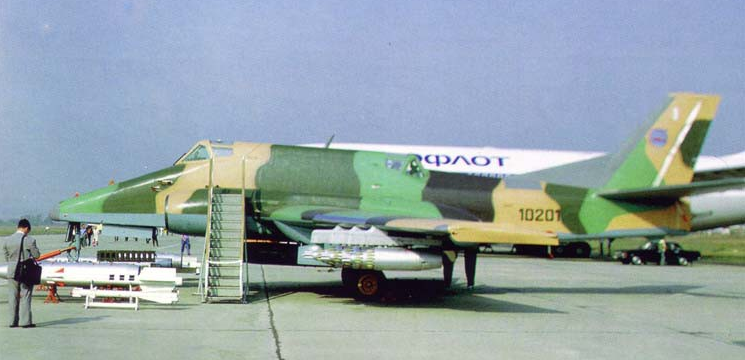
Compared with the IL-42, the new two-seater IL-102 attack aircraft had a modified shape of the front fuselage with a better forward-down view, new, more powerful engines and improved armament. The most notable difference between the Il-102 and the Su-25 was the presence of a second cockpit for the shooter and a mobile defensive installation with 23-mm GSH-23. It was assumed that a highly maneuverable armored attack aircraft equipped with electronic warfare equipment, infrared traps and a defensive installation would be weakly vulnerable even when meeting with enemy fighters. In addition, not without reason, it was believed that the side shooters with the help of the fodder 23-mm gun would be able to suppress anti-aircraft guns and MANPADS when leaving the attack. On tests, the minimum radius of the IL-102 turn was only 400 m. For comparison, the turn radius of the Su-25 with a normal combat load is 680 m, while the empty one is about 500 m.
Armament IL-102 was very powerful. Two 30-mm GSH-301 guns with 500 rounds of ammunition and liquid-cooled guns were mounted in the ventral removable swinging carriage, which locks in two positions. At the site of a removable gun carriage, bombs weighing up to 500 kg or additional fuel tanks could be hung. A load of up to 7200 kg could be placed on the sixteen suspension nodes and in the six internal bomb compartments. Three internal bomb compartments were in the wing consoles, bombs weighing up to 250 kg could be placed there.
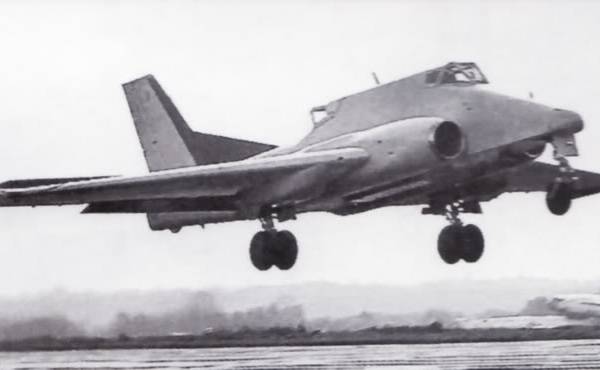
The first flight of the Il-102 attack aircraft took place 25 September 1982 of the year. The plane was actually tested illegally, as Minister of Defense D.F. Ustinov categorically banned the chief designer G.V. Novozhilov "engage in amateur." Over the two years of testing, the IL-102 performed more than 250 flights and proved itself to be positive, showing high reliability and improved design. With two engines I-88 (unformatted version RD-33) with 5380 kgf, the aircraft showed a maximum speed of 950 km / h. With a maximum take-off mass of 22000 kg, the combat radius with the maximum combat load was 300 km. Ferry range - 3000 km.
IL-102 was frankly late, although it exceeded the Su-25 in combat load and had large internal volumes, which in the future made it possible to mount various equipment without any problems. But in conditions when the Su-25 was built in series and positively established itself in Afghanistan, the leadership of the USSR Ministry of Defense did not see the need for parallel adoption of an attack aircraft with similar characteristics.
With all the advantages of the Su-25, in its arsenal were mainly uncontrolled anti-tank weapons. In addition, he was able to act mainly during the day, and only visually visible goals. As is known, in the armed forces of technologically advanced countries, tanks and motorized infantry are fighting under the umbrella of a military air defense: mobile self-propelled anti-aircraft systems, short-range anti-aircraft missile systems and MANPADS. Under these conditions, Su-25 body armor does not guarantee invulnerability. Therefore, it was quite logical to equip the attack aircraft with long-range ATGMs and a modern optoelectronic system ensuring the search and destruction of point targets, beyond the limits of the action of military air defense weapons. The modified Su-25T attack aircraft were supposed to be equipped with PrNK-56 equipment with a television channel 23-x multiple magnification. The main anti-tank caliber attack aircraft was supposed to be a new ATGM "Whirlwind", developed in the Tula Instrument Design Bureau.
The calculations showed that for sure defeat from above modern tanks of the type M1 Abrams and Leopard-2, an aircraft gun of at least 45-mm caliber, with high-speed projectiles, with a core of dense solid material is required. However, later the installation of the 45-mm guns was refused, and the old 30-mm GSH-30-2 remained on the plane. The formal reason was the assertion that the 45-mm gun has a relatively low efficiency when firing at promising samples of armored vehicles and the need to get close to the tank at close range. In fact, the Ministry of Defense did not want to expand the already very wide range of aviation ammunition, while the military was supported by officials of the Ministry of Industry responsible for the release of new projectiles.
Since the placement of an additional highly voluminous avionics required additional space, Su-25Т decided to build on the basis of the Sparky Su-25UT. Based on operating and combat experience, the airframe and aircraft systems of the upgraded attack aircraft made a number of significant changes in line with the increased requirements for survivability and operational manufacturability. This approach to the design of the Su-25T provided a high constructive and technological continuity with the two-seater combat training Su-25UB.
In place of the cockpit of the second pilot is a compartment for electronic equipment, and under the electronic units an additional soft fuel tank. Compared to the Su-25, the Su-25T is outwardly distinguished by a bulky gargrotom behind the cockpit, the nose of the aircraft has become longer and wider. The gun installation was moved under the fuel tank and shifted from the axis of the aircraft to the right by 273 mm. The volumes obtained were used for the installation of the new Squall optical sighting system. Automated sighting system "Squall" provides the use of all types of aircraft armament attack aircraft day and night, including air targets. Navigation, flight and sight information on all flight modes of the aircraft is displayed by the information display system on the windshield. The solution of the problems of using all types of weapons, as well as the navigation of the aircraft is carried out by the central computer.
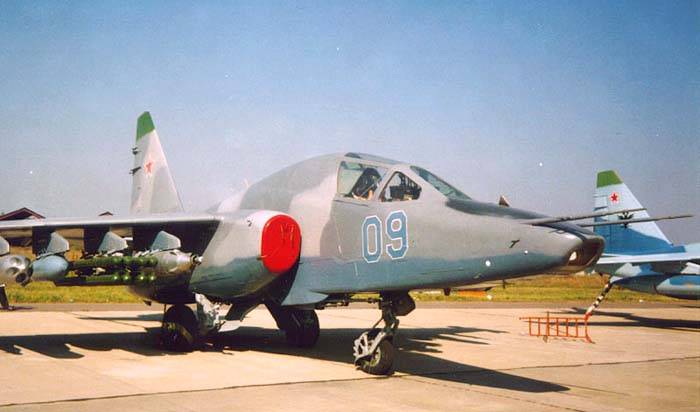
The middle part of the fuselage and the engine air intakes are completely identical to the Su-25UB. To compensate for the increased fuel consumption in the rear fuselage is an additional soft fuel tank. Engine nacelles were revised to install new, more powerful P-195 engines. Increasing the aircraft's thrust ratio was required to maintain flight data at the level of the Su-25, since the maximum take-off weight of the Su-25T increased by almost 2 tons. The wing of the Su-25T is completely borrowed from the Su-25UB. In the containers of the brake plates installed new antenna system EW "Gardenia."
Under each wing there are five armament suspension units, including 4 girder BDZ-25 holders, providing suspension and use of all types of bomber, unguided and guided armament, as well as suspended fuel tanks, and one pylon holder for installing a launch device for a rocket air-to-air P-60M. On the nodes of the suspension nearest to the fuselage side, bombs weighing up to 1000 kg can be placed.
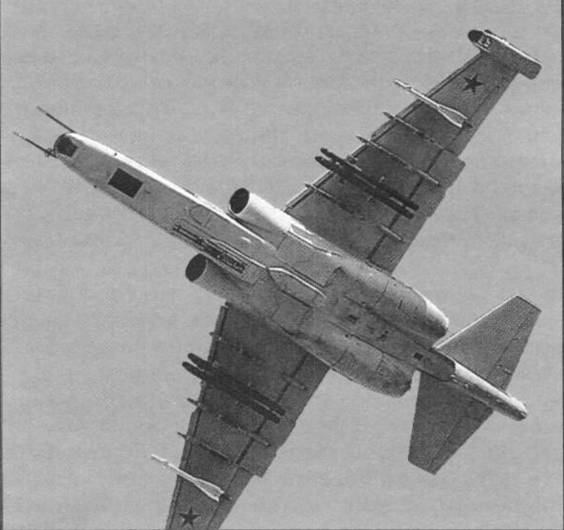
The maximum weight of the combat load remained the same as on the Su-25. The main anti-tank weapon Su-25T are 16 ATGM "Whirlwind". The complex allows firing single rockets and a volley of two missiles. The high supersonic speed of the ATGM (near 600 m / s) makes it possible to hit several targets in one run and reduces the time the wearer is in the zone of the military air defense. The laser-beam targeting system of an anti-tank guided missile at a target, in combination with an automated tracking system, allows to obtain very high firing accuracy, which practically does not depend on the range. At a distance of 8 km, the probability of a rocket hitting a tank moving at a speed of 15-20 km / h is 80%. In addition to point ground and sea targets, the Vortex ATGM can be used against low-level and relatively slow air targets, such as helicopters or military transport aircraft.
An ATGM with a mass of 45 kg (weight with TPK 59 kg) capable of hitting targets during the day at a distance of up to 10 km. The range of effective use at night does not exceed 6 km. Cumulative fragmentation warhead weighing 8 kg according to advertising data breaks 800 mm homogeneous armor. In addition to the "Whirlwind" ATGM, the Su-25T can carry the entire range of anti-tank weapons previously used on the Su-25, including two detachable mobile guns SPPU-687 with 30-mm air cannon GSH-1-30.
The tests of the Su-25T were delayed due to the high complexity of the avionics and the need to pair it with guided weapons. Only for 1990, the aircraft was prepared for launch into mass production at the Tbilisi Aviation Production Association. From 1991, the transition to the serial production of attack aircraft with advanced anti-tank weapons was planned, with the gradual curtailment of the production of Su-25. However, the reduction of military spending, and later the collapse of the USSR put an end to these plans. Until the end of 1991, it was possible to build and fly around the entire 8 Su-25T. At the factory, the reserve still remained on 12 attack aircraft that are in varying degrees of readiness. Apparently, part of the Su-25T remaining in Georgia managed to finish.
According to media reports 4 Su-25T fought in 1999 in the North Caucasus. The attackers made about 30 combat missions, during which they fired precision guided missile positions with guided aviation munitions. But the combat use of Su-25T in Chechnya was limited due to the small stock of guided weapons. Several aircraft modified to the level of Su-25TK were delivered to Ethiopia at the end of 1999. These machines were actively used during the Ethiopian-Eritrean war. During the attack of the 20 XDUMX mobile squadron medium-range airborne positions in May 2000, an anti-aircraft missile exploded next to one of the Su-25ТК, but the attack aircraft withstood the strike, and despite the damage safely reached the base.
A further development option for the Su-25T was the Su-25TM. But the task of fighting tanks for Su-25TM is not a priority. Compared to the Su-25, the mass of armor on the Su-25TM was reduced by 153 kg, but at the same time, the fire protection was improved on the basis of the combat damage analysis. The design of the central part of the fuselage, the fuel system mains and the thrust control system have also been intensified.
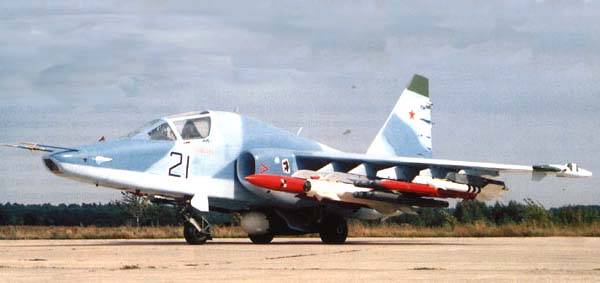
The new attack aircraft was to become a multi-purpose vehicle, capable of effectively fighting enemy tactical and transport aircraft and destroying warships in the coastal zone. In order to expand the functionality of the designed attack aircraft, an overhead radar "Spear-25" of three-centimeter range with a slot antenna array with a diameter of 500 mm and a weight of 90 kg was introduced into the avionics.
Suspended radar station container type "Spear-25" provides all-weather use of weapons, mapping areas, detection and pre-targeting in various modes, significantly expanding the range of combat tasks Su-25TM. Thanks to the use of radar, it became possible to use anti-ship missiles X-31А and X-35. Su-25TM is capable of carrying four anti-ship missiles. Air targets with EPR 5 m² can be detected on a collision course at a distance of up to 55 km, on catch-up courses - 27 km. The radar simultaneously accompanies up to 10 and provides the use of missiles for two air targets. In the improved version of the Kopyo-M station, the range of detection of airborne targets "head-on" is 85 km, followed by 40 km. A convoy of armored vehicles can be detected at a distance of 20-25 km. At the same time, the weight of the upgraded station increased to 115 kg.
The Su-25TM anti-tank weapons remain the same as on the Su-25T. The upgraded optoelectronic station Shkval-M is placed in the forward part of the fuselage, the image from which is fed to a television monitor. When approaching the target, at a distance of 10-12 km OEPS begins to work in scan mode. Depending on the height of the flight, a strip of terrain width from 500 m to 2 km is viewed. The equipment "Squall-M" allows you to recognize the tank at a distance of 8-10 km. The target identified by the pilot is taken to auto-follow by a television machine with image memorization, and during spatial maneuvers, the target is kept on tracking, while simultaneously determining the distance. This ensures not only the use of guided weapons, but the accuracy of unguided weapons of destruction increases several times.
The tests of the Su-25TM, which received the “export” designation of the Su-39, began in the 1995 year. Serial production of modernized attack aircraft was supposed to be organized at an aircraft factory in Ulan-Ude, where Su-25UB’s “Sparky” were built before. In various domestic sources indicated that the total was built 4 prototype.
In addition to expanding combat capabilities, the installation of the radar on the attack aircraft had a number of significant drawbacks. Considerable weight and dimensions allow to place it only in the outboard container, which significantly reduces the attack load of the attack aircraft. The station has a high power consumption on the tests worked reliably. The detection range of air and ground targets and low resolution do not correspond to modern conditions.
Instead of building new Su-25ТМ (Su-39), the leadership of the Defense Ministry of the Russian Federation chose to order overhaul and modernization of the front-line Su-25 having a sufficiently high residual life on the glider. For a number of reasons listed above, it was decided to abandon the overhead container radar. The upgraded attack aircraft received the designation Su-25CM. Its combat capabilities have been enhanced through the use of the new 56CM Bars sighting and navigation system. The complex is controlled by a digital computer Digital Center-90. It includes a multifunctional color indicator, satellite and near-navigation equipment, an electronic reconnaissance station, an aircraft responder, a weapon control system, an on-board system for collecting, processing and recording flight information and a number of other systems. From the old avionics on the attack aircraft remained only a laser sight-rangefinder "Klen-PS".
Due to the transition to a new, lighter avionics, it was possible to reduce the weight of the onboard equipment by approximately 300 kg. This allowed the use of mass reserve to improve the security of the Su-25CM. On the upgraded attack aircraft, thanks to the introduction of the built-in onboard equipment control system, labor costs were significantly reduced when preparing the aircraft for re-departure. But the anti-tank capabilities of the Su-25CM after the modernization have not changed much. Representatives of the Russian Aerospace Forces voiced information that the Su-25CM could be in operation for another 15-20 years. However, the updated BREO modernized attack aircraft practically did not contribute to an increase in anti-tank potential.
Relatively recently, information appeared about the new modification of the attack aircraft - Su-25CM3. This machine is also not endowed with special anti-tank properties like Su-25T / TM. The major improvements to the avionics were made in the direction of increasing the capabilities of anti-aircraft and anti-aircraft combat weapons. Su-25MX3 received a new electronic warfare system Vitebsk, which includes a radar monitoring system, ultraviolet direction-finding equipment for missile launches, as well as a powerful multi-frequency jammer. According to officially not confirmed information, the electronic countermeasures system includes not only an irradiation warning station, but also a laser facility for blinding infrared-guided missiles, in addition to heat traps.
According to the Military Balance 2016 data, last year there were: 40 Su-25, 150 upgraded Su-25СМ / СМ3 and 15 Sparok Su-25UB with the RF AJS. Apparently, this is data taking into account machines that are “in storage” and in the process of modernization. But among the two hundred attackers available, the anti-Su-25T / TM is not officially listed.
In the middle of the 90-ies, in the course of “reforming and optimizing” the armed forces, under the pretext of low efficiency and the struggle to improve flight safety, fighter-bomber aircraft were eliminated. I must say that even at the beginning of the 80-s, the leadership of the USSR Ministry of Defense set a course for equipping the air force with twin-engine machines. This was supposed to reduce the number of flight accidents and increase combat survivability. Under this pretext, all Su-17 and MiG-27 were sent to “storage”, and the air regiments equipped with them were disbanded. Impact functions were assigned to the Su-24M front-line bombers, the Su-25 attack planes and the MiG-29 and Su-27 fighters. Especially "good" in the role of the anti-tank machine looked heavy fighter Su-27 with blocks of the NAR.
During the Second Chechen War, it turned out that the Su-24M bombers are not optimal for carrying out a number of tactical tasks; moreover, these aircraft require thorough and very time-consuming service and place high demands on the qualifications of pilots. At the same time, the Su-25 attack planes, simple and relatively inexpensive to operate, do not have the capability of daily and all-weather use, and also have a number of restrictions on the use of guided weapons. Here, the Russian generals, confronted with the fierce resistance of Chechen gangster formations, recalled the Su-17М4 and MiG-27К / M, which, with acceptable operating costs, could deliver pinpoint strikes with guided bombs and missiles. However, it soon became clear that after several years of “storage” in the open air, fighter-bombers, which are formally in stock, are only suitable for scrap metal. Although in flight test centers and at an aircraft factory in Komsomolsk-on-Amur, where they were properly cared for, the training Su-17UM was decommissioned only recently.
In the past few years, with the filing of the leadership of the Russian Aerospace Force of the Russian Federation, the media have been spreading statements that front-line bombers Su-34 can replace all other strike aircraft of front-line aviation. Such statements, of course, are slyness designed to disguise the losses suffered by our military aircraft in the years of "rising from its knees." Su-34 is certainly a wonderful aircraft, capable of effectively destroying targeted critical objects with controlled weapons and striking area targets with free-fall bombs. The front-line bomber of the new generation Su-34, if necessary, can successfully conduct a defensive air battle. But his anti-tank capabilities remained at about the level of the old Su-24M.
To be continued ...
Based on:
http://saper.isnet.ru/mines/ptm-3.html
http://www.airwar.ru/weapon/ab/kmgu.html
http://army.lv/ru/su-25/primenenie/482/144
http://foto-i-mir.ru/kopie-25-maks-2003/
http://www.redov.ru/transport_i_aviacija/shturmoviki_i_istrebiteli_bombardirovshiki/p25.php
- Linnik Sergey
- Aviation against tanks (part of 1)
Aviation against tanks (part of 2)
Aviation against tanks (part of 3)
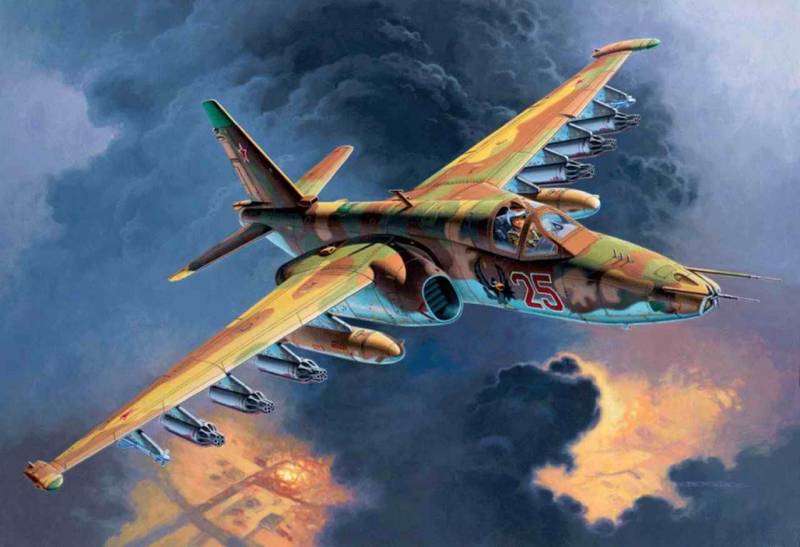
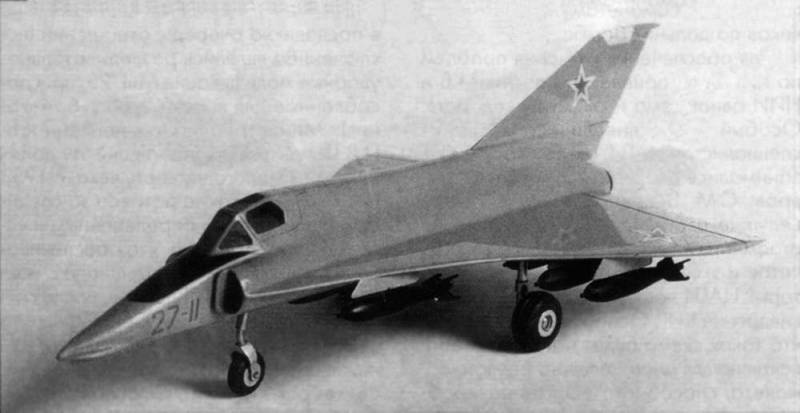
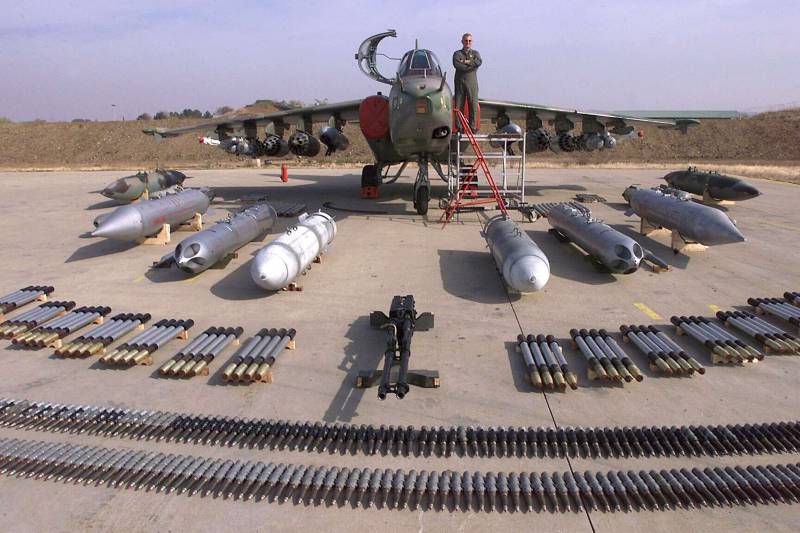
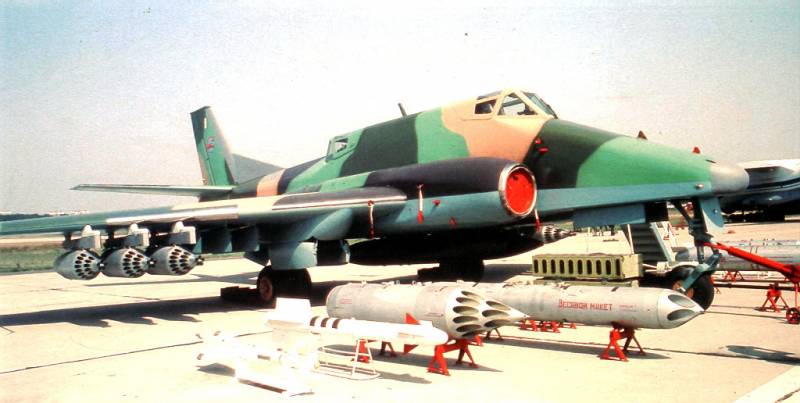
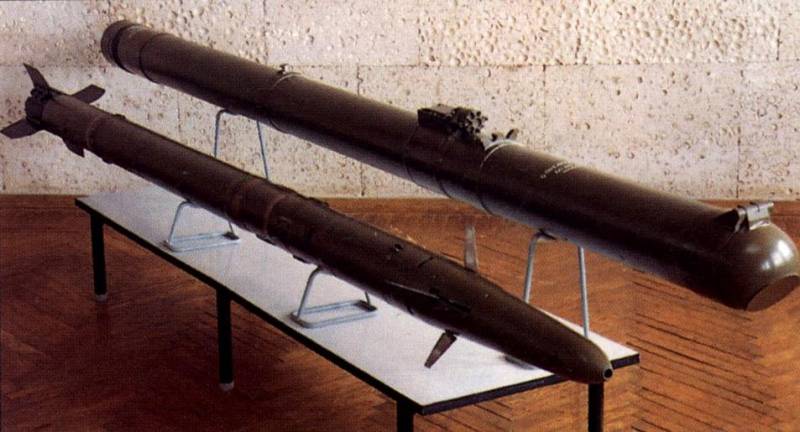
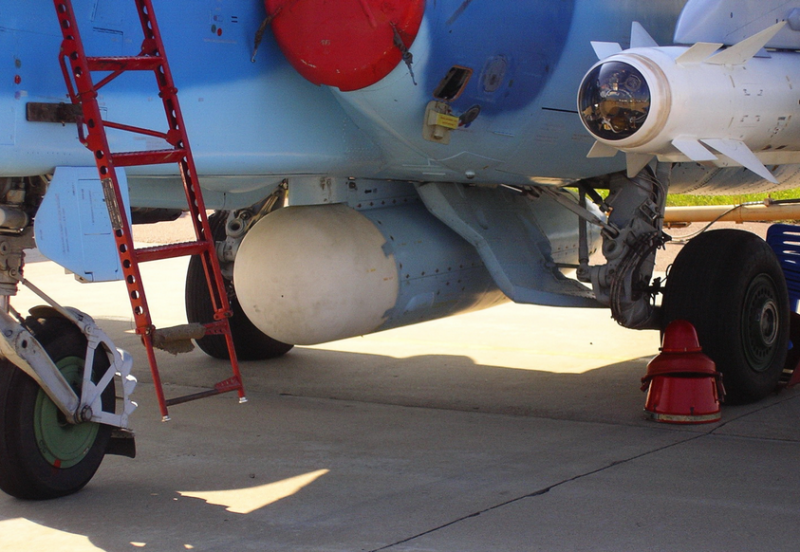
Information